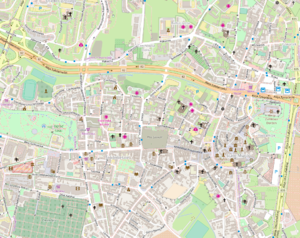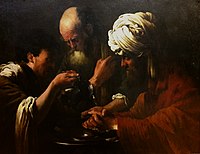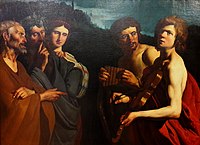
Lublin is the ninth-largest city in Poland and the second-largest city of historical Lesser Poland. It is the capital and the centre of Lublin Voivodeship with a population of 336,339. Lublin is the largest Polish city east of the Vistula River, located 153 km (95 mi) southeast of Warsaw.

Kazimierz Józef Marian Michałowski was a Polish archaeologist and Egyptologist, art historian, member of the Polish Academy of Sciences, professor ordinarius of the University of Warsaw as well as the founder of the Polish Centre of Mediterranean Archaeology. He coined the term "Nubiology" to refer to the study of ancient Nubia.
"National Museum of Poland" is the common name for several of the country's largest and most notable museums. Poland's National Museum comprises several independent branches, each operating a number of smaller museums. The main branch is the National Museum in Kraków, established in 1879. It has several hundred thousand items in its permanent collections, kept mostly at the Main Building at 3 Maja St., and partly in eight other divisions around the city.

The Warsaw National Museum, also known as the National Museum in Warsaw, is a national museum in Warsaw, one of the largest museums in Poland and the largest in the capital. It comprises a rich collection of ancient art, counting about 11,000 pieces, an extensive gallery of Polish painting since the 16th century and a collection of foreign painting including some paintings from Adolf Hitler's private collection, ceded to the museum by the American authorities in post-war Germany. The museum is also home to numismatic collections, a gallery of applied arts and a department of oriental art, with the largest collection of Chinese art in Poland, comprising some 5,000 objects.

Kozłówka Palace is a large rococo and neoclassical palace complex of the Zamoyski family in Kozłówka, Lubartów County, Lublin Voivodeship in eastern Poland.

Maidstone Museum is a local authority-run museum located in Maidstone, Kent, England, featuring internationally important collections including fine art, natural history, and human history. The museum is one of three operated by Maidstone Borough Council. The building is Grade II* listed.

The National Museum in Kraków, popularly abbreviated as MNK, is the largest museum in Poland, and the main branch of Poland's National Museum, which has several independent branches with permanent collections around the country. Established in 1879, the museum consists of 21 departments which are divided by art period: 11 galleries, 2 libraries, and 12 conservation workshops. It holds some 780,000 art objects, spanning from classical archeology to modern art, with special focus on Polish painting. In 2023, the museum was visited by over 1.65 million people, making it the third most-visited art museum in Poland and the 37th most-visited art museum in the world.

The Gallery of 19th-Century Polish Art at Sukiennice, is a division of the National Museum, Kraków, Poland. The gallery is housed on the upper floor of the Renaissance Sukiennice Cloth Hall in the center of the Main Market Square in Old Town Kraków.

The Department of Asia in the British Museum holds one of the largest collections of historical objects from Asia. These collections comprise over 75,000 objects covering the material culture of the Asian continent, and dating from the Neolithic age up to the present day.

The National Museum in Poznań, Poland, abbreviated MNP, is a state-owned cultural institution and one of the largest museums in Poland. It houses a rich collection of Polish painting from the 16th century on, and a collection of foreign painting. The museum is also home to numismatic collections and a gallery of applied arts.
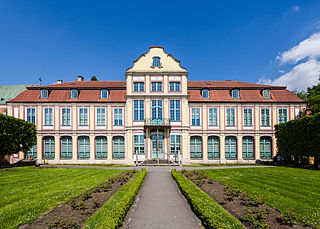
The Abbots' Palace in Oliwa is a rococo palace in Oliwa, a quarter of Gdańsk. It houses the Department of Modern Art of the National Museum in Gdańsk, and along with the Cistercian-Cathedral complex in Oliwa it is listed as a Historic Monument of Poland.

The National Museum in Gdańsk, established in 1972 in Gdańsk, is one of the main branches of Poland's national museum system.

Jan Nepomucen Głowacki was a Polish realist painter of the Romantic era, regarded as the most outstanding landscape painter of the early 19th century in Poland under the foreign partitions. Głowacki studied painting at the Kraków School of Fine Arts and later at the academies of Prague and Vienna, as well as Rome and Munich. He returned to Kraków in 1828, and became a teacher of painting and drawing. From 1842 he served as a professor in the Faculty of Landscape Painting at the School of Fine Arts. His work can be found at the National Museum of Poland and its branches. Some of his work was looted by Nazi Germany in World War II and has never been recovered.
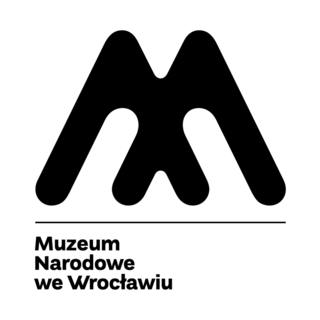
The National Museum in Wrocław, established 28 March 1947 and officially inaugurated on 11 July 1948, is one of Poland's main branches of the National Museum system. It holds one of the largest collections of contemporary art in the country.

National Museum in Kielce is a museum located in the Palace of the Kraków Bishops, Kielce, Poland. Its collections include valuable exhibits in the field of painting, handicraft, folk art, archeology, and natural sciences.

Muzeum Sztuki, or the Museum of Art in Łódź, is a museum of modern and contemporary art in Łódź, Poland, whose main goal is to research and display the history of avant-garde art, with a focus on Central and Eastern Europe. Founded in 1931, Muzeum Sztuki became the first museum in Europe and the second museum in the world dedicated to collecting and showcasing modern art.
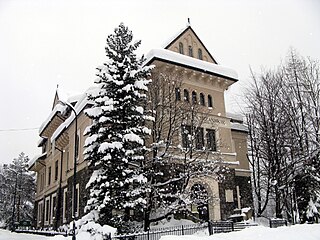
The Tatra Museum is a museum of the history, culture, nature and ethnography of the Polish Tatras; its main branch is located in Zakopane, Poland.

The Professor Kazimierz Michałowski Faras Gallery at the National Museum in Warsaw is a permanent gallery at the National Museum in Warsaw, presenting Nubian early Christian art. The Gallery features a unique collection of wall paintings and architectural elements from the Faras Cathedral, discovered by an archeological expedition led by Professor Kazimierz Michałowski.

The Leon Wyczółkowski Regional Museum is an ensemble of cultural institutions which have been first created in 1923 in the city of Bydgoszcz, Poland.

The Babin Republic is an oil painting by Jan Matejko from 1881. This painting depicts a meeting of the Babin Republic, a literary society founded in the sixteenth-century Polish–Lithuanian Commonwealth which left a long-lasting impression on Polish culture. Currently, the painting is in the collection of the Warsaw National Museum.

